brakes PONTIAC GRAND PRIX 2006 Owners Manual
[x] Cancel search | Manufacturer: PONTIAC, Model Year: 2006, Model line: GRAND PRIX, Model: PONTIAC GRAND PRIX 2006Pages: 472, PDF Size: 2.82 MB
Page 100 of 472
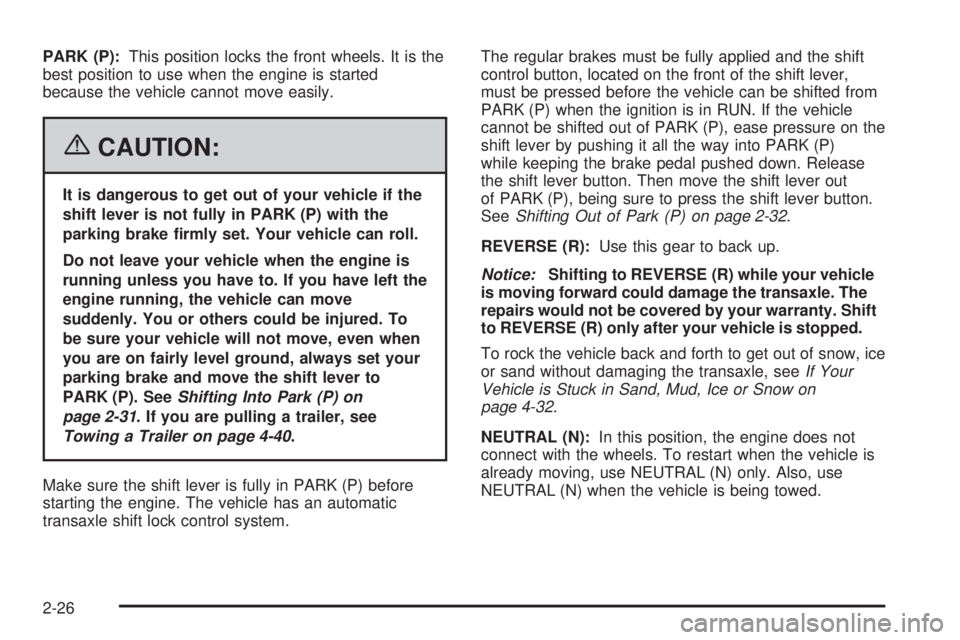
PARK (P):This position locks the front wheels. It is the
best position to use when the engine is started
because the vehicle cannot move easily.
{CAUTION:
It is dangerous to get out of your vehicle if the
shift lever is not fully in PARK (P) with the
parking brake �rmly set. Your vehicle can roll.
Do not leave your vehicle when the engine is
running unless you have to. If you have left the
engine running, the vehicle can move
suddenly. You or others could be injured. To
be sure your vehicle will not move, even when
you are on fairly level ground, always set your
parking brake and move the shift lever to
PARK (P). SeeShifting Into Park (P) on
page 2-31. If you are pulling a trailer, see
Towing a Trailer on page 4-40.
Make sure the shift lever is fully in PARK (P) before
starting the engine. The vehicle has an automatic
transaxle shift lock control system.The regular brakes must be fully applied and the shift
control button, located on the front of the shift lever,
must be pressed before the vehicle can be shifted from
PARK (P) when the ignition is in RUN. If the vehicle
cannot be shifted out of PARK (P), ease pressure on the
shift lever by pushing it all the way into PARK (P)
while keeping the brake pedal pushed down. Release
the shift lever button. Then move the shift lever out
of PARK (P), being sure to press the shift lever button.
SeeShifting Out of Park (P) on page 2-32.
REVERSE (R):Use this gear to back up.
Notice:Shifting to REVERSE (R) while your vehicle
is moving forward could damage the transaxle. The
repairs would not be covered by your warranty. Shift
to REVERSE (R) only after your vehicle is stopped.
To rock the vehicle back and forth to get out of snow, ice
or sand without damaging the transaxle, seeIf Your
Vehicle is Stuck in Sand, Mud, Ice or Snow on
page 4-32.
NEUTRAL (N):In this position, the engine does not
connect with the wheels. To restart when the vehicle is
already moving, use NEUTRAL (N) only. Also, use
NEUTRAL (N) when the vehicle is being towed.
2-26
Page 102 of 472
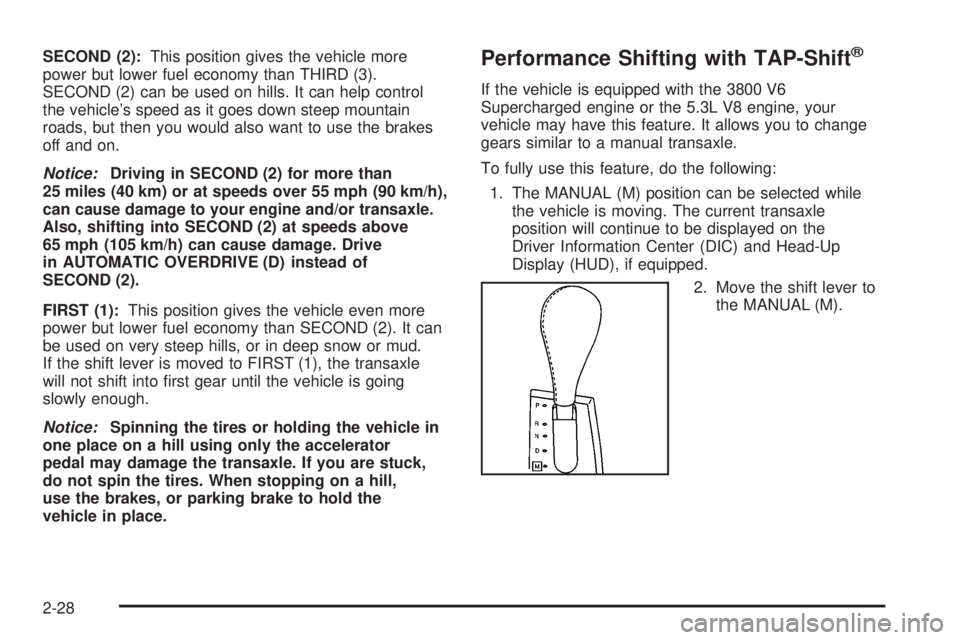
SECOND (2):This position gives the vehicle more
power but lower fuel economy than THIRD (3).
SECOND (2) can be used on hills. It can help control
the vehicle’s speed as it goes down steep mountain
roads, but then you would also want to use the brakes
off and on.
Notice:Driving in SECOND (2) for more than
25 miles (40 km) or at speeds over 55 mph (90 km/h),
can cause damage to your engine and/or transaxle.
Also, shifting into SECOND (2) at speeds above
65 mph (105 km/h) can cause damage. Drive
in AUTOMATIC OVERDRIVE (D) instead of
SECOND (2).
FIRST (1):This position gives the vehicle even more
power but lower fuel economy than SECOND (2). It can
be used on very steep hills, or in deep snow or mud.
If the shift lever is moved to FIRST (1), the transaxle
will not shift into �rst gear until the vehicle is going
slowly enough.
Notice:Spinning the tires or holding the vehicle in
one place on a hill using only the accelerator
pedal may damage the transaxle. If you are stuck,
do not spin the tires. When stopping on a hill,
use the brakes, or parking brake to hold the
vehicle in place.Performance Shifting with TAP-Shift®
If the vehicle is equipped with the 3800 V6
Supercharged engine or the 5.3L V8 engine, your
vehicle may have this feature. It allows you to change
gears similar to a manual transaxle.
To fully use this feature, do the following:
1. The MANUAL (M) position can be selected while
the vehicle is moving. The current transaxle
position will continue to be displayed on the
Driver Information Center (DIC) and Head-Up
Display (HUD), if equipped.
2. Move the shift lever to
the MANUAL (M).
2-28
Page 106 of 472
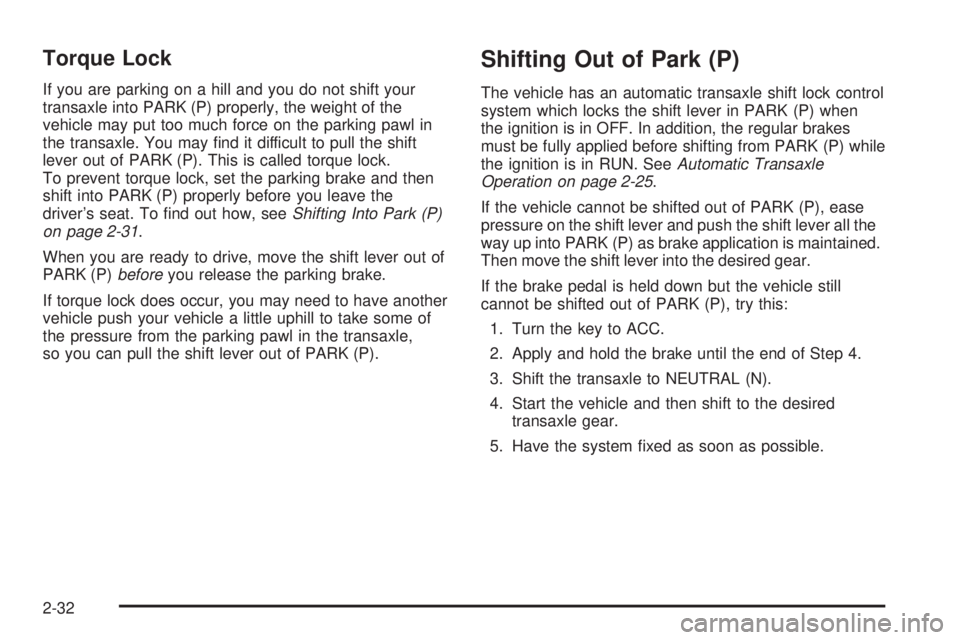
Torque Lock
If you are parking on a hill and you do not shift your
transaxle into PARK (P) properly, the weight of the
vehicle may put too much force on the parking pawl in
the transaxle. You may �nd it difficult to pull the shift
lever out of PARK (P). This is called torque lock.
To prevent torque lock, set the parking brake and then
shift into PARK (P) properly before you leave the
driver’s seat. To �nd out how, seeShifting Into Park (P)
on page 2-31.
When you are ready to drive, move the shift lever out of
PARK (P)beforeyou release the parking brake.
If torque lock does occur, you may need to have another
vehicle push your vehicle a little uphill to take some of
the pressure from the parking pawl in the transaxle,
so you can pull the shift lever out of PARK (P).
Shifting Out of Park (P)
The vehicle has an automatic transaxle shift lock control
system which locks the shift lever in PARK (P) when
the ignition is in OFF. In addition, the regular brakes
must be fully applied before shifting from PARK (P) while
the ignition is in RUN. SeeAutomatic Transaxle
Operation on page 2-25.
If the vehicle cannot be shifted out of PARK (P), ease
pressure on the shift lever and push the shift lever all the
way up into PARK (P) as brake application is maintained.
Then move the shift lever into the desired gear.
If the brake pedal is held down but the vehicle still
cannot be shifted out of PARK (P), try this:
1. Turn the key to ACC.
2. Apply and hold the brake until the end of Step 4.
3. Shift the transaxle to NEUTRAL (N).
4. Start the vehicle and then shift to the desired
transaxle gear.
5. Have the system �xed as soon as possible.
2-32
Page 131 of 472
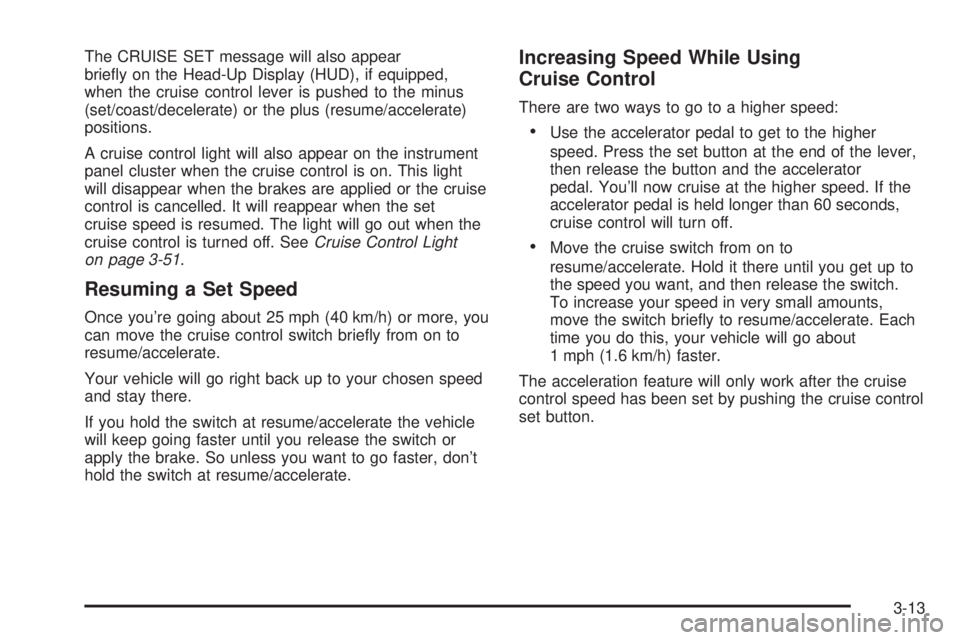
The CRUISE SET message will also appear
brie�y on the Head-Up Display (HUD), if equipped,
when the cruise control lever is pushed to the minus
(set/coast/decelerate) or the plus (resume/accelerate)
positions.
A cruise control light will also appear on the instrument
panel cluster when the cruise control is on. This light
will disappear when the brakes are applied or the cruise
control is cancelled. It will reappear when the set
cruise speed is resumed. The light will go out when the
cruise control is turned off. SeeCruise Control Light
on page 3-51.
Resuming a Set Speed
Once you’re going about 25 mph (40 km/h) or more, you
can move the cruise control switch brie�y from on to
resume/accelerate.
Your vehicle will go right back up to your chosen speed
and stay there.
If you hold the switch at resume/accelerate the vehicle
will keep going faster until you release the switch or
apply the brake. So unless you want to go faster, don’t
hold the switch at resume/accelerate.
Increasing Speed While Using
Cruise Control
There are two ways to go to a higher speed:
Use the accelerator pedal to get to the higher
speed. Press the set button at the end of the lever,
then release the button and the accelerator
pedal. You’ll now cruise at the higher speed. If the
accelerator pedal is held longer than 60 seconds,
cruise control will turn off.
Move the cruise switch from on to
resume/accelerate. Hold it there until you get up to
the speed you want, and then release the switch.
To increase your speed in very small amounts,
move the switch brie�y to resume/accelerate. Each
time you do this, your vehicle will go about
1 mph (1.6 km/h) faster.
The acceleration feature will only work after the cruise
control speed has been set by pushing the cruise control
set button.
3-13
Page 132 of 472
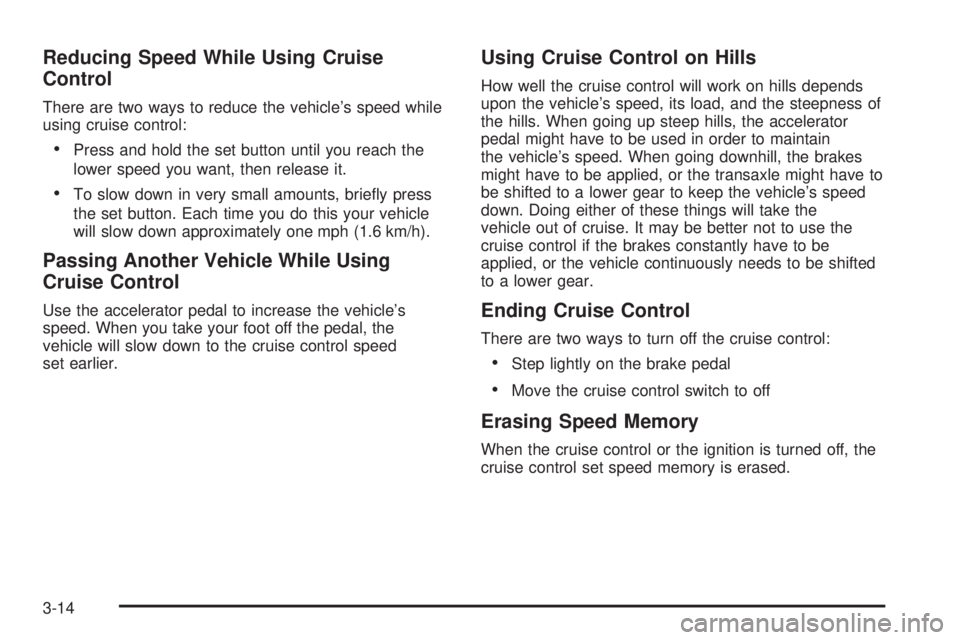
Reducing Speed While Using Cruise
Control
There are two ways to reduce the vehicle’s speed while
using cruise control:
Press and hold the set button until you reach the
lower speed you want, then release it.
To slow down in very small amounts, brie�y press
the set button. Each time you do this your vehicle
will slow down approximately one mph (1.6 km/h).
Passing Another Vehicle While Using
Cruise Control
Use the accelerator pedal to increase the vehicle’s
speed. When you take your foot off the pedal, the
vehicle will slow down to the cruise control speed
set earlier.
Using Cruise Control on Hills
How well the cruise control will work on hills depends
upon the vehicle’s speed, its load, and the steepness of
the hills. When going up steep hills, the accelerator
pedal might have to be used in order to maintain
the vehicle’s speed. When going downhill, the brakes
might have to be applied, or the transaxle might have to
be shifted to a lower gear to keep the vehicle’s speed
down. Doing either of these things will take the
vehicle out of cruise. It may be better not to use the
cruise control if the brakes constantly have to be
applied, or the vehicle continuously needs to be shifted
to a lower gear.
Ending Cruise Control
There are two ways to turn off the cruise control:
Step lightly on the brake pedal
Move the cruise control switch to off
Erasing Speed Memory
When the cruise control or the ignition is turned off, the
cruise control set speed memory is erased.
3-14
Page 162 of 472
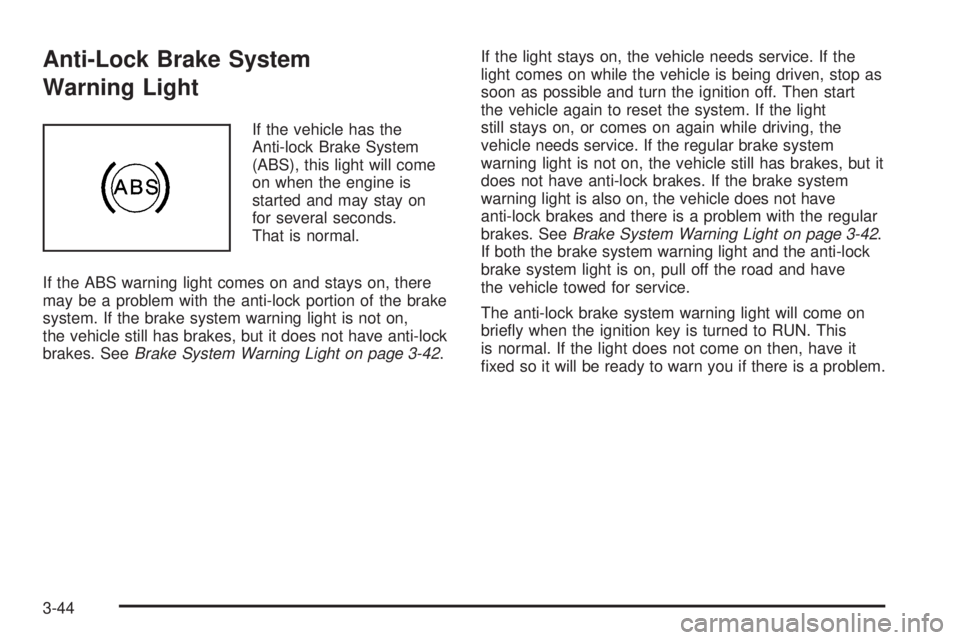
Anti-Lock Brake System
Warning Light
If the vehicle has the
Anti-lock Brake System
(ABS), this light will come
on when the engine is
started and may stay on
for several seconds.
That is normal.
If the ABS warning light comes on and stays on, there
may be a problem with the anti-lock portion of the brake
system. If the brake system warning light is not on,
the vehicle still has brakes, but it does not have anti-lock
brakes. SeeBrake System Warning Light on page 3-42.If the light stays on, the vehicle needs service. If the
light comes on while the vehicle is being driven, stop as
soon as possible and turn the ignition off. Then start
the vehicle again to reset the system. If the light
still stays on, or comes on again while driving, the
vehicle needs service. If the regular brake system
warning light is not on, the vehicle still has brakes, but it
does not have anti-lock brakes. If the brake system
warning light is also on, the vehicle does not have
anti-lock brakes and there is a problem with the regular
brakes. SeeBrake System Warning Light on page 3-42.
If both the brake system warning light and the anti-lock
brake system light is on, pull off the road and have
the vehicle towed for service.
The anti-lock brake system warning light will come on
brie�y when the ignition key is turned to RUN. This
is normal. If the light does not come on then, have it
�xed so it will be ready to warn you if there is a problem.
3-44
Page 163 of 472
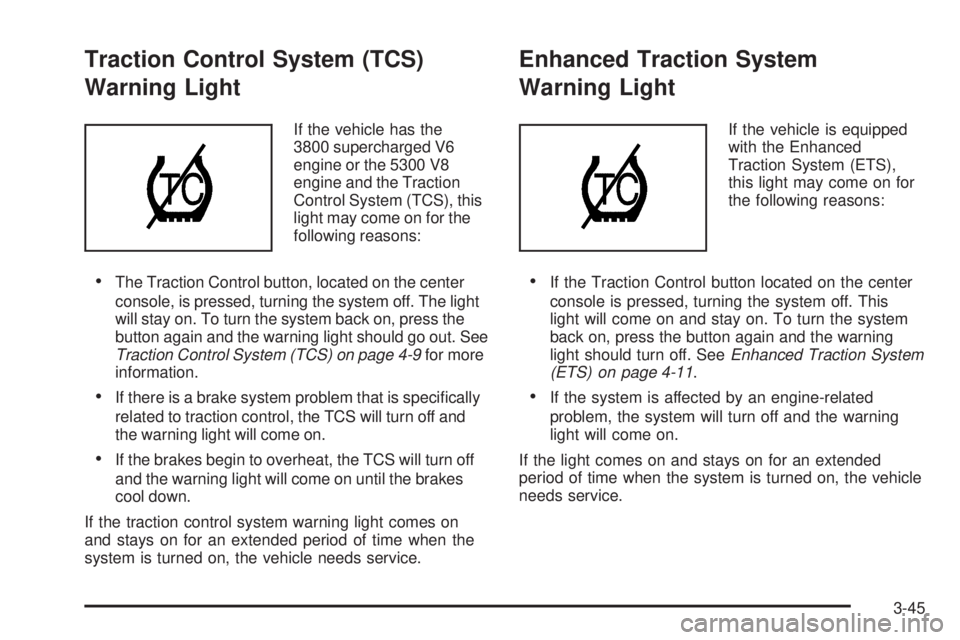
Traction Control System (TCS)
Warning Light
If the vehicle has the
3800 supercharged V6
engine or the 5300 V8
engine and the Traction
Control System (TCS), this
light may come on for the
following reasons:
The Traction Control button, located on the center
console, is pressed, turning the system off. The light
will stay on. To turn the system back on, press the
button again and the warning light should go out. See
Traction Control System (TCS) on page 4-9for more
information.
If there is a brake system problem that is speci�cally
related to traction control, the TCS will turn off and
the warning light will come on.
If the brakes begin to overheat, the TCS will turn off
and the warning light will come on until the brakes
cool down.
If the traction control system warning light comes on
and stays on for an extended period of time when the
system is turned on, the vehicle needs service.
Enhanced Traction System
Warning Light
If the vehicle is equipped
with the Enhanced
Traction System (ETS),
this light may come on for
the following reasons:
If the Traction Control button located on the center
console is pressed, turning the system off. This
light will come on and stay on. To turn the system
back on, press the button again and the warning
light should turn off. SeeEnhanced Traction System
(ETS) on page 4-11.
If the system is affected by an engine-related
problem, the system will turn off and the warning
light will come on.
If the light comes on and stays on for an extended
period of time when the system is turned on, the vehicle
needs service.
3-45
Page 168 of 472
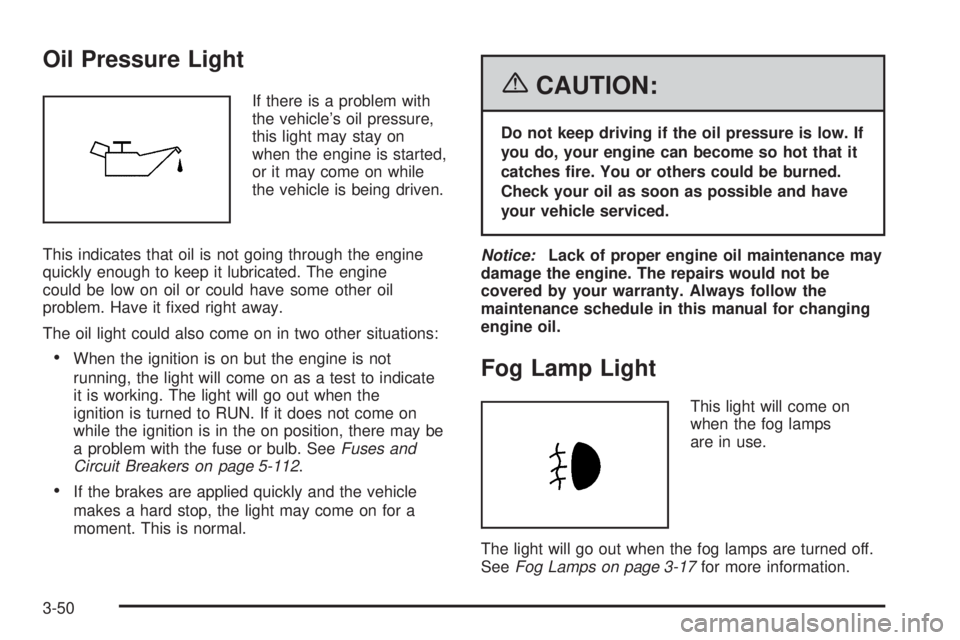
Oil Pressure Light
If there is a problem with
the vehicle’s oil pressure,
this light may stay on
when the engine is started,
or it may come on while
the vehicle is being driven.
This indicates that oil is not going through the engine
quickly enough to keep it lubricated. The engine
could be low on oil or could have some other oil
problem. Have it �xed right away.
The oil light could also come on in two other situations:
When the ignition is on but the engine is not
running, the light will come on as a test to indicate
it is working. The light will go out when the
ignition is turned to RUN. If it does not come on
while the ignition is in the on position, there may be
a problem with the fuse or bulb. SeeFuses and
Circuit Breakers on page 5-112.
If the brakes are applied quickly and the vehicle
makes a hard stop, the light may come on for a
moment. This is normal.
{CAUTION:
Do not keep driving if the oil pressure is low. If
you do, your engine can become so hot that it
catches �re. You or others could be burned.
Check your oil as soon as possible and have
your vehicle serviced.
Notice:Lack of proper engine oil maintenance may
damage the engine. The repairs would not be
covered by your warranty. Always follow the
maintenance schedule in this manual for changing
engine oil.
Fog Lamp Light
This light will come on
when the fog lamps
are in use.
The light will go out when the fog lamps are turned off.
SeeFog Lamps on page 3-17for more information.
3-50
Page 193 of 472
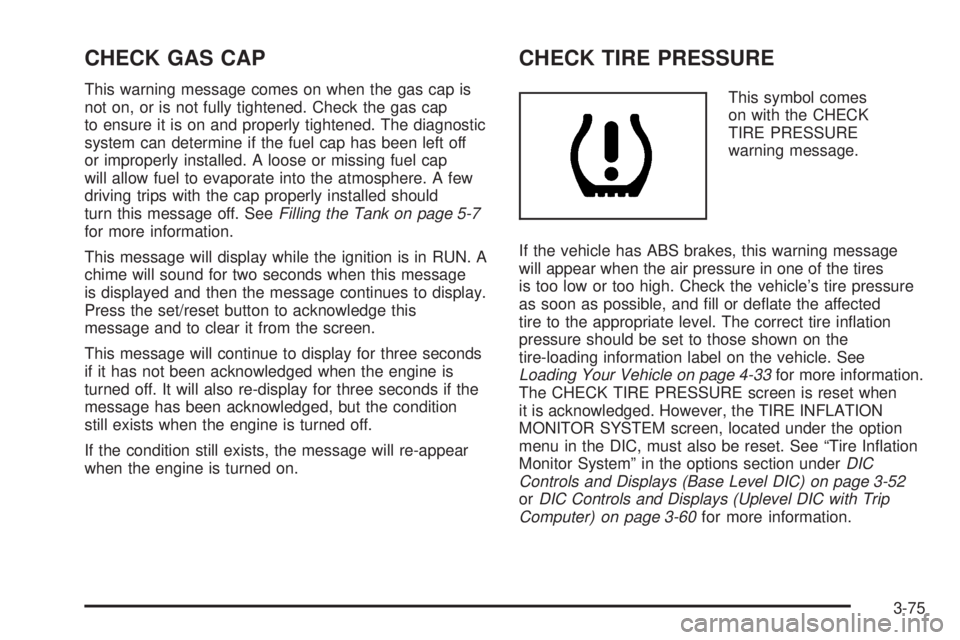
CHECK GAS CAP
This warning message comes on when the gas cap is
not on, or is not fully tightened. Check the gas cap
to ensure it is on and properly tightened. The diagnostic
system can determine if the fuel cap has been left off
or improperly installed. A loose or missing fuel cap
will allow fuel to evaporate into the atmosphere. A few
driving trips with the cap properly installed should
turn this message off. SeeFilling the Tank on page 5-7
for more information.
This message will display while the ignition is in RUN. A
chime will sound for two seconds when this message
is displayed and then the message continues to display.
Press the set/reset button to acknowledge this
message and to clear it from the screen.
This message will continue to display for three seconds
if it has not been acknowledged when the engine is
turned off. It will also re-display for three seconds if the
message has been acknowledged, but the condition
still exists when the engine is turned off.
If the condition still exists, the message will re-appear
when the engine is turned on.
CHECK TIRE PRESSURE
This symbol comes
on with the CHECK
TIRE PRESSURE
warning message.
If the vehicle has ABS brakes, this warning message
will appear when the air pressure in one of the tires
is too low or too high. Check the vehicle’s tire pressure
as soon as possible, and �ll or de�ate the affected
tire to the appropriate level. The correct tire in�ation
pressure should be set to those shown on the
tire-loading information label on the vehicle. See
Loading Your Vehicle on page 4-33for more information.
The CHECK TIRE PRESSURE screen is reset when
it is acknowledged. However, the TIRE INFLATION
MONITOR SYSTEM screen, located under the option
menu in the DIC, must also be reset. See “Tire In�ation
Monitor System” in the options section underDIC
Controls and Displays (Base Level DIC) on page 3-52
orDIC Controls and Displays (Uplevel DIC with Trip
Computer) on page 3-60for more information.
3-75
Page 198 of 472
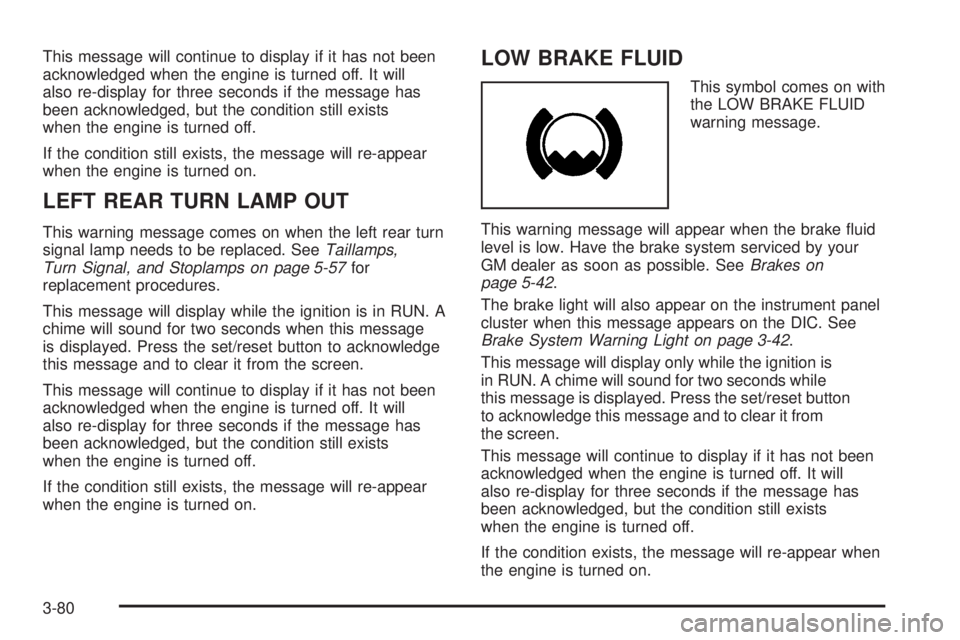
This message will continue to display if it has not been
acknowledged when the engine is turned off. It will
also re-display for three seconds if the message has
been acknowledged, but the condition still exists
when the engine is turned off.
If the condition still exists, the message will re-appear
when the engine is turned on.
LEFT REAR TURN LAMP OUT
This warning message comes on when the left rear turn
signal lamp needs to be replaced. SeeTaillamps,
Turn Signal, and Stoplamps on page 5-57for
replacement procedures.
This message will display while the ignition is in RUN. A
chime will sound for two seconds when this message
is displayed. Press the set/reset button to acknowledge
this message and to clear it from the screen.
This message will continue to display if it has not been
acknowledged when the engine is turned off. It will
also re-display for three seconds if the message has
been acknowledged, but the condition still exists
when the engine is turned off.
If the condition still exists, the message will re-appear
when the engine is turned on.
LOW BRAKE FLUID
This symbol comes on with
the LOW BRAKE FLUID
warning message.
This warning message will appear when the brake �uid
level is low. Have the brake system serviced by your
GM dealer as soon as possible. SeeBrakes on
page 5-42.
The brake light will also appear on the instrument panel
cluster when this message appears on the DIC. See
Brake System Warning Light on page 3-42.
This message will display only while the ignition is
in RUN. A chime will sound for two seconds while
this message is displayed. Press the set/reset button
to acknowledge this message and to clear it from
the screen.
This message will continue to display if it has not been
acknowledged when the engine is turned off. It will
also re-display for three seconds if the message has
been acknowledged, but the condition still exists
when the engine is turned off.
If the condition exists, the message will re-appear when
the engine is turned on.
3-80